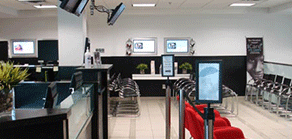ULTRA SOUND
Pachymetry is an efficient and accurate way to measure corneal thickness.
PROCEDURE
For Pachymetry testing, you will be seated in a chair in the diagnostic procedure room. During the test, a technician will have you look in a certain direction so that you are concentrating on a central point of focus. The technician will then give you a topical anesthesia.
The topical anesthesia is necessary so the technician can use a probe to touch the corneal surface of the eye.
POTENTIAL SIDE EFFECTS
A corneal abrasion can occur from use of the probe directly on the corneal surface, but this is very rare. This is more likely to occur in patients with history of dry eye. Patching the eye overnight may be required to speed up the healing process should a corneal abrasion occur.
BENEFITS
Pachymetry is a useful screening tool for patients who are suspected to be developing glaucoma as well as a monitoring tool for those already diagnosed. Corneal thickness is also important to detect minimal corneal edema is surgical cases of cataracts.
A-SCAN
The most common use of the A-scan is to determine eye length for calculation of intraocular lens power.
PROCEDURE
For A-Scan testing, you will be seated in a chair in the diagnostic procedure room.During the test, a technician will have you look in certain direction so that you are concentrating on a central point of focus.
The technician will then give you a topical anesthesia. The topical anesthesia is necessary so the technician can use a probe to touch the corneal surface of the eye.
BENEFITS
The A-Scan provides data on the length of the eye which aids in calculations for intraocular lenses.
B-SCAN
Ultrasound is a test that uses sound waves to assess ocular and retinal conditions. If your doctor cannot view the retina because of some opacity that blocks the view, he or she may use an ultrasound to determine the general status of the retina. Ultrasound is commonly used to assess the retina in patients with a dense cataract or vitreous hemorrhage.
PROCEDURE
You will be seated in a chair in the diagnostic procedure room. During the test, the doctor will have you close your eyes. A jelly will be placed on the surface of your eye lid to allow for the probe to be used properly. A hand held probe is placed directly on the eyelid and emits waves that are then turned into images. This is similar to other ultrasounds done on your body.
POTENTIAL SIDE EFFECTS
There are no side effects when having this test completed. Ultrasound is simple to perform, painless, and does not involve any radiation.
BENEFITS
B-Scans help to provide better comprehensive care to patients. The ultrasound can assist in measuring different parts of the eye and aid in recognizing pathology such as tumors which are not easily seen by other methods.

